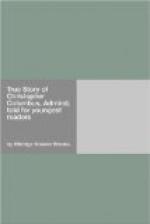On the twenty-seventh of November, the fleet of the Admiral cast anchor off the solitary fort. It was night. No light was to be seen on the shore; through the darkness nothing could be made out that looked like the walls of the fort. Columbus fired a cannon; then he fired another. The echoes were the only answer. They must be sound sleepers in our fortress there, said the Admiral. At last, over the water he heard the sound of oars—or was it the dip of a paddle? A voice called for the Admiral; but it was not a Spanish voice. The interpreter—who was the only one left of those ten stolen Indians carried by Columbus to Spain—came to the Admiral’s side; by the light of the ship’s lantern they could make out the figure of an Indian in his canoe. He brought presents from his chief. But where are my men at the fort? asked the Admiral. And then the whole sad story was told.
The fort of La Navidad was destroyed; the Spaniards were all dead; the first attempt of Spain to start a colony in the new world was a terrible failure. And for it the Spaniards themselves were to blame.
After Columbus had left them, the forty men in the fort did not do as he told them or as they had solemnly promised. They were lazy; they were rough; they treated the Indians badly; they quarreled among themselves; some of them ran off to live in the woods. Then sickness came; there were two “sides,” each one jealous of the other; the Indians became enemies. A fiery war-chief from the hills, whose name was Caonabo, led the Indians against the white men. The fort and village were surprised, surrounded and destroyed. And the little band of “conquerors”—as the Spaniards loved to call themselves—was itself conquered and killed.
It was a terrible disappointment to Columbus. The men in whom he had trusted had proved false. The gold he had told them to get together they had not even found. His plans had all gone wrong.
But Columbus was not the man to stay defeated. His fort was destroyed, his men were killed, his settlement was a failure. It can’t be helped now, he said. I will try again.
This time he would not only build a fort, he would build a city. He had men and material enough to do this and to do it well. So he set to work.
But the place where he had built from the wreck of the unlucky Santa Maria his unlucky fort of La Navidad did not suit him. It was low, damp and unhealthy. He must find a better place. After looking about for some time he finally selected a place on the northern side of the island. You can find it if you look at the map of Hayti in the West Indies; it is near to Cape Isabella.
He found here a good harbor for ships, a good place on the rocks for a fort, and good land for gardens. Here Columbus laid out his new town, and called it after his friend the queen of Spain, the city of Isabella.




